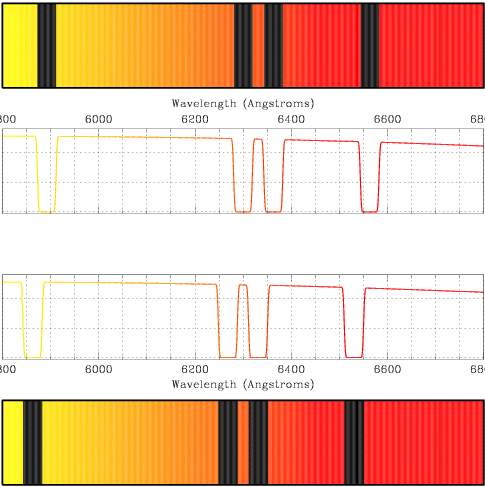

Summary of results:
Maria Mitchell's score on this quiz was 100%.
#1. Solar eclipses are observed during the .
#2. The figure below shows the roughly circular orbit of a star within a spectroscopic binary system (with a stellar companion too faint to see). If the magnesium stellar absorption line is observed at 5203 Angstroms when the star is at position 1 and at 5213 Angstroms when the star is at position 3, what is its observed wavelength at position 4, in units of Angstroms?
#3. If you observe a optical binary with an appropriate telescope on a clear night, an image of the sky will show .
#4. If a neutron star appears to be a pulsar to us here on Earth, would it also appear as a pulsar to a radio astronomer in any other solar system in the Milky Way who detected it?
#5. The figure drawn below consists of optical spectra for two galaxies, showing a
set of common emission or absorption line features in both spectra. The top
spectrum contains features at the wavelengths at which they are observed in
the laboratory, while the bottom spectrum shows these features as they would
appear in the spectrum of another galaxy, one moving relative to the Milky Way.
Is the spectrum of the other galaxy redshifted or blueshifted?
Elapsed Time: 2.88 minutes
#1.
Solar eclipses are observed during the .| night | day |
A solar eclipse occurs when the Moon blocks the light of the noon sun from reaching the Earth. This requires a near perfect alignment of the Earth, the Moon, and the Sun. In order to observe it, one must be on the side of the Earth facing the Sun (which is to say, during the day).


#2.
The figure below shows the roughly circular orbit of a star within a spectroscopic binary system (with a stellar companion too faint to see). If the magnesium stellar absorption line is observed at 5203 Angstroms when the star is at position 1 and at 5213 Angstroms when the star is at position 3, what is its observed wavelength at position 4, in units of Angstroms? |
In positions 2 and 4, the star will move across the sky but shift neither toward nor away from us. The spectrum should thus be the same in these two cases, and the magnesium line will appear at its rest wavelength. This rest wavelength is the average of the wavelengths observed at positions 1 and 3, and (5203 + 5213) ÷ 2 = 5208 Angstroms. Find it in the figure shown below – it is the third of three closely spaced lines in the green portion of the spectrum.
In position 1, the star moves toward us and is therefore Doppler shifted to bluer (shorter) wavelengths. The magnesium feature moves from 5208 to 5203 Angstroms. In position 3, the star moves away from us and is therefore Doppler shifted to redder (longer) wavelengths. Its speed is unchanged, but now it takes the star away from us rather than toward us. As the blueshift moved the absorption line feature from 5208 to 5203 Angstroms (a -5 Angstrom shift), the redshift will move it from 5208 to 5213 Angstroms (a +5 Angstrom shift). When we average the redshifted and blueshifted wavelengths, these shifts cancel out to reveal the rest wavelength of the line.
| Position 1 |  |
| Position 2 |  |
| Position 3 |  |
| Position 4 |  |


#3.
If you observe a optical binary with an appropriate telescope on a clear night, an image of the sky will show .| two stars, which are in orbit around each other |
| three stars, which are in orbit around each other |
| two stars, which appear close to each other on the sky but in reality are not the same distance from Earth |
| one star, with a fainter close companion that could only be discovered through follow-up spectroscopy |
In an optical binary system, the two stars appear close together on the sky but one is much further away from us than the other. They just appear to lie close to one another when viewed from Earth.


#4.
If a neutron star appears to be a pulsar to us here on Earth, would it also appear as a pulsar to a radio astronomer in any other solar system in the Milky Way who detected it?| Yes | No |
A neutron star is a pulsar if its rotational axis and its magnetic axis are not aligned with each other. It will pulse as its radio signal passes over a planet, and then go silent until the magnetic pole returns to the same location. The observed frequency of a pulsar is determined by how quickly it rotates around on its rotational axis, and has nothing to do with the location from where it is observed.
The Earth, for example, rotates once on its rotational axis every 24 hours. If we observed its rotation from Mars and from Venus, it would be observed to spin around once each day from either location.


#5.
The figure drawn below consists of optical spectra for two galaxies, showing a set of common emission or absorption line features in both spectra. The top spectrum contains features at the wavelengths at which they are observed in the laboratory, while the bottom spectrum shows these features as they would appear in the spectrum of another galaxy, one moving relative to the Milky Way.Is the spectrum of the other galaxy redshifted or blueshifted?
| blueshifted | redshifted |

We can see that all of the emission line features in the top spectrum have shifted to the left in the lower spectrum. The peak at 5892 Angstroms, for example, has shifted over by -29 Angstroms to 5863 Angstroms, while the peak at 6563 Angstroms has shifted over by -33 Angstroms to 6530 Angstroms.
As all features have shifted to the left, to shorter wavelengths and bluer colours, we say that this spectrum is blueshifted.

